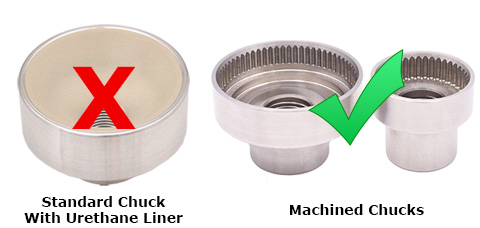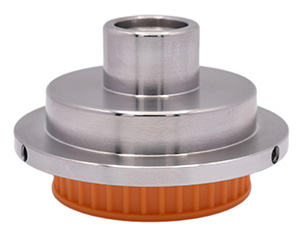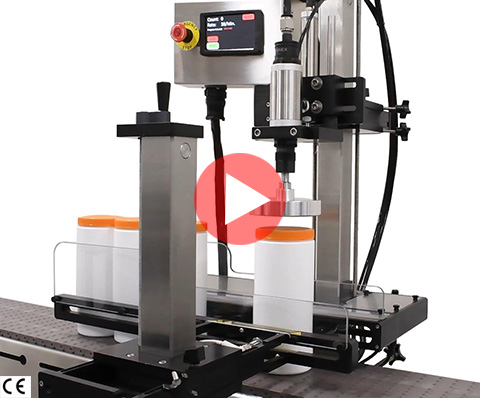Decapping is the process of unscrewing a threaded cap or closure from a bottle or container. Companies often need to decap their bottles for reasons such as quality control checks, reprocessing due to manufacturing defects, or regulatory compliance. These activities are typically conducted as limited-scale or sample-based processes, rather than as part of continuous, high-volume operations.
The processes of capping and decapping a bottle are quite distinct from one another. The capping process begins with a loose cap. The capping machine grips the loose cap, then accelerates to its normal operating speed before applying a specified torque to tighten the cap. On the other hand, decapping starts with a cap that is already tightly secured. Since the cap is already tight, the machine must instantly apply a reverse torque without the opportunity to first ramp up to operating speed. Because of this, the machine must have a strong and immediate grip on the cap to enable it to instantly generate sufficient torque to loosen the tight cap.
Choosing the Right Capping Machine to De-Cap Your Bottles
Benchtop Capping Machines are usually the Best Choice
Benchtop capping machines, such as our SA™ benchtop capper and PumpCap™ trigger capper, are usually the optimal choice for decapping due to their suitability for limited-scale or sample-based processes. Compared to fully automatic capping machines, benchtop models offer enhanced flexibility and are easier and less time consuming to set up, making them ideal for handling smaller batches efficiently. Additionally, benchtop machines provide ergonomic benefits over handheld capping machines. They are designed to be more comfortable for the operator to use, reducing fatigue and improving productivity. This combination of ease of setup, operational efficiency, and operator comfort often makes a benchtop capping machine the best choice for decapping tasks.
Decapping with an Automatic Capping Machine
For decapping applications that require handling large volumes efficiently, such as during large-scale product recalls or high-volume batch testing, automatic capping machines are the ideal solution. These machines are also an excellent choice when decapping is a regular part of the workflow, such as when products must be decapped before a specific stage on the bottling line.
Decapping with Hand Held Capping Machines
Because decapping applications are generally sample based, or short run, hand held capping machines are frequently a good fit. When considering using a hand held capping machine as a decapper, it is important to first assess the release torque of the caps you will be removing. Release torque refers to the amount of torque required to remove the cap from the bottle.
For caps requiring low to moderate release torque, any of our handheld capping machines will suit your needs. However, if high torque is necessary, using a handheld machine can be straining and fatiguing. This is because the operator must hold the hand capper still during the decapping process to prevent it from rotating in their hands. As the machine produces the required torque to remove the cap, the operator must exert an equal amount of torque in the opposite direction to stabilize it, which for high torque applications can be strenuous.
If you have a high torque application and think a hand capping machine best meets your needs, then our PS™ PowerCap handheld capping machine is a great choice. The PS™ PowerCap is a handheld capping machine specifically designed to handle high-torque applications. The PS™ PowerCap allows you to remove caps comfortably and ergonomically, as it includes a torque stabilizing arm that holds the machine still during the decapping process, thereby eliminating all the twisting torque generated during the decapping process and protecting the operator from repetitive strain.
Options & Accessories
Machined Chucks are the Best Choice for most Decapping Applications
In most cases a standard chuck with urethane or white rubber chuck insert (liner) cannot provide enough gripping power to remove a tight cap. The liner simply skids over the cap without removing it. For this reason, the vast majority of de-capping jobs require a machined chuck. Machined chucks are custom made to fit the rib pattern of a particular cap. A machined chuck fits a cap like a socket fits a nut, creating excellent gripping power and making the removal of even the highest release torque caps very easy.

Cap Retaining Machined Chucks are ideal for Decap and Recap Operations
While machined chucks are the best choice for the vast majority of decapping applications, a special type of machined chuck called a cap retaining machined chuck is useful for decapping applications in which the cap will be reapplied almost immediately after is has been removed. A cap retaining chuck is a machined chuck that is designed with additional features that allow it to grasp and retain the cap it is designed to work with. When decapping a container using a cap retaining chuck, the cap remains in the chuck after it has been removed from the container. This makes it ideal for use when you want to reapply the cap shortly after it has been removed.

Cap Retaining Chuck
Choose a Capping Machine (Decapping Machine) with an Adjustable Runtime
Many capping machines, including ours, are designed to tighten a cap until they receive a signal indicating that the cap is tight, at which point they stop immediately. However, when these machines unscrew a cap, they do not receive the signal to stop. As a result, the cap is fully loosened almost instantly, but the capping motor continues to rotate counterclockwise for several more turns before the operator can react to shut it off. This excess of rotations causes the cap to repeatedly climb and then abruptly drop back down onto the threads of the container. This “dropping” action not only generates considerable noise but also significantly erodes the plastic threads of the caps and bottles, often producing plastic dust from the resulting friction.
If you are purchasing a capping machine to decap containers, it is very important that it includes an adjustable runtime. This feature enables you to control how long the capping motor runs, which is typically only a fraction of a second to fully remove a cap. Correctly adjusting the runtime ensures that the capping motor operates only long enough to completely loosen a cap, but no more, thereby eliminating the problems caused by rotating the cap unnecessarily.




